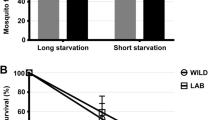Abstract
Brugia malayi is one of the important lymphatic filarial nematodes that cause elephantiasis and disability in humans in the Asian region. Mass production at any stage of this nematode in both small laboratory animal hosts and mosquito vectors is still necessary in order to continue various research aspects. This study elucidated on the use of nonblood feeding or the autogenous Ochlerotatus togoi (Thailand strain) and male Mongolian jird (Meriones unguiculatus) system. This has brought about a low-cost and highly-effective procedure for the mass production of blood containing microfilariae, infective (L3) larvae, and adults of B. malayi under nonanimal-blood-feeding insectary and small-space animal-house conditions. The highly-infective rates (human-heparinized blood, 86.67–93.33; swine-heparinized blood, 83.33–96.67; bovine-heparinized blood, 76.67–80; chicken-heparinized blood, 73.33–76.67) and parasite loads (human-heparinized blood, 10.58–12.36; swine-heparinized blood, 8.40–10.38; bovine-heparinized blood, 9.75–9.91; chicken-heparinized blood, 3.41–4.65) of autogenous O. togoi to B. malayi and high numbers of adults recovered from ten B. malayi-infected male jirds (total = 327, 16–52) are good supportive evidence. In addition, all special techniques required for succeeding in the establishment of a facile system regarding these matters are detailed.




Similar content being viewed by others
References
Aliota MT, Fuchs JF, Rocheleau TA, Clark AK, Hillyer JF, Chen CC, Christensen BM (2010) Mosquito transcriptome profiles and filarial worm susceptibility in Armigeres subalbatus. PLoS Negl Trop Dis. doi:10.1371/journal.pntd.0000666
Ash LR (1973) Chronic Brugia pahangi and Brugia malayi infections in Meriones unguiculatus. J Parasitol 59:442–447
Ash LR, Riley JM (1970) Development of subperiodic Brugia malayi in the jirds, Meriones unguiculatus, with notes on infection in other rodents. J Parasitol 56:969–973
Choochote W, Keha P, Sukhavat K, Khamboonruang C, Sukontason K (1987) Aedes (Finlaya) togoi Theobald 1907, Chanthaburi strain, a laboratory vector in studies of filariasis in Thailand. Southeast Asian J Trop Med Public Health 18:259–260
Choochote W, Chaithong U, Somboon P, Pakdicharoen A, Tookyang B, Likitvong K, Siriprasert V, Sukontason K, Thitasut P (1991) Small laboratory animal model for nocturnally superiodic Brugia malayi (Narathiwat Province, Southern Thailand strain). J Trop Med Parasitol 14:51–58
Choochote W, Saeung A (2013) Systematic techniques for the recognition of Anopheles species complexes. In: Manguin S (ed) Anopheles mosquitoes—new insights into malaria vectors. InTech, Rijeka (in press)
Denham DA, McGreevy PB (1977) Brugian filariasis: epidemiology and experimental studies. Adv Parasitol 15:243–309
Edeson JF, Wharton RH (1957) The transmission of Wuchereria malayi from man to the domestic cat. Trans Royal Soc Trop Med Hyg 51:366–370
el-Bihari S, Ewert A (1973) Worm burdens and prepatent periods in jirds (Meriones unguiculatus) infected with Brugia malayi. Southeast Asian J Trop Med Public Health 4:184–186
Harinasuta C, Sucharit S, Choochote W (1981) The susceptibility of leaf monkeys to bancroftian filariasis in Thailand. Southeast Asian J Trop Med Public Health 12:581–589
Junkum A, Choochote W, Jitpakdi A, Leemingsawat S, Komalamisra N, Jariyapan N, Boonyatakorn C (2003) Comparative studies on the biology and filarial susceptibility of selected blood-feeding and autogenous Aedes togoi sub-colonies. Mem Inst Oswaldo Cruz 98:481–485
Krushna NS, Shiny C, Manokaran G, Elango S, Babu S, Narayanan RB (2011) Immune responses to recombinant Brugia malayi pepsin inhibitor homolog (Bm-33) in patients with human lymphatic filariaisis. Parasitol Res 108:407–415
McCall JW, Malone JB, Hyong-Sun A, Thompson PE (1973) Mongolian jirds (Meriones unguiculatus) infected with Brugia pahangi by intraperitoneal route: a rich source of developing larvae, adult filariae, and microfilariae. J Parasitol 59:436
MacDonald WW (1962) The selection of a strain of Aedes aegypti susceptible to infection with semi-periodic Brugia malayi. Ann Trop Med Parasitol 56:368–372
Michalski ML, Erickson SM, Bartholomay LC, Christensen BM (2010) Midgut barrier imparts selective resistance to filarial worm infection in Culex pipiens pipiens. PLoS Negl Trop Dis. doi:10.1371/journal.pntd.0000875
Nayar JK, Knight JW (1995) Wounding increases intracellular encapsulation (melanization) of developing Brugia malayi (Nematoda: Filarioidea) larvae in thoracic muscles of Anopheles quadrimaculatus. Comp Biochem Physiol 112(3–4):553–557
Ramachandran CP, Wharton RH, Dunn FL, Kershaw WE (1963) Aedes (Finlaya) togoi Theobald, a useful laboratory vector in studies of filariasis. Ann Trop Med Parasitol 57:443–445
Riyong D, Choochote W, Jitpakdi A, Suvannadabba S, Leemingsawat S, Chaithong U (2000) Autogenous Aedes togoi sub-colony (Chanthaburi, Thailand strain), an efficient laboratory vector in study of filariasis. Southeast Asian J Trop Med Public Health 31:246–251
Saeung A, Hempolchom C, Baimai V, Thongsahuan S, Taai K, Jariyapan N, Chaithong U, Choochote W (2013) Susceptibility of eight species members of Anopheles hyrcanus group to nocturnally subperiodic Brugia malayi. Parasit Vectors 6:5
Thirugnanam S, Munirathinam G, Veerapathran A, Dakshinamoorthy G, Reddy MV, Ramaswamy K (2012) Cloning and characterization of high mobility group box protein 1 (HMGB1) of Wuchereria bancrofti and Brugia malayi. Parasitol Res 111:619–627
Tompkins JB, Stitt LE, Morrissette AM, Ardelli BF (2011) The role of Brugia malayi ATP-binding cassette (ABC) transporters in potentiating drug sensitivity. Parasitol Res 109:1311–1322
World Health Organization (2011) Global programme to eliminate lymphatic filariasis: progress report on mass drug administration, 2010. Wkly Epidemiol Rec 86:377–388
Acknowledgments
This work was supported by funding awarded to W. Choochote and A. Saeung from the Thailand Research Fund (TRF Senior Research Scholar: RTA5480006) and Diamond Research Grant of the Faculty of Medicine, Chiang Mai University.
Author information
Authors and Affiliations
Corresponding author
Rights and permissions
About this article
Cite this article
Saeung, A., Choochote, W. Development of a facile system for mass production of Brugia malayi in a small-space laboratory. Parasitol Res 112, 3259–3265 (2013). https://doi.org/10.1007/s00436-013-3504-2
Received:
Accepted:
Published:
Issue Date:
DOI: https://doi.org/10.1007/s00436-013-3504-2




